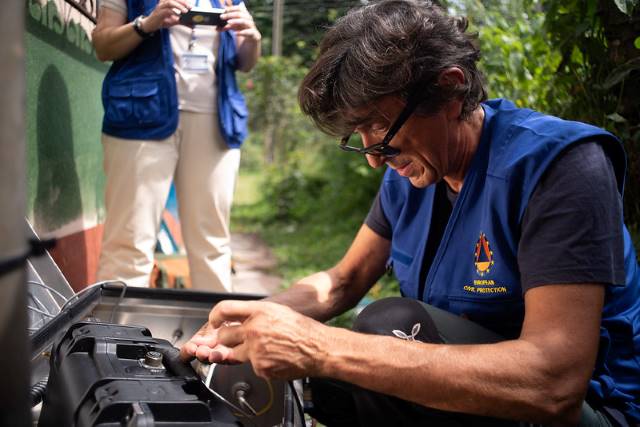Preventing Poverty: Solutions to Volcanic Eruptions
 Throughout history, volcanic eruptions have caused countless injuries, deaths and destruction. Many of the eruptions include concurrent disasters beyond the direct flow of lava. These include tsunamis, agricultural deterioration and aerosols that cloud the atmosphere and reduce local or even global temperatures. This was the case during and after the eruption of Tambora in Indonesia in 1815, which claimed more than 100,000 lives. Since then, volcanoes continue to cause numbers of casualties while damaging infrastructure and impacting productivity around the globe. Many people view volcanoes as unstoppable forces of nature. In reality, there are several ways to mitigate the damage that volcanoes cause and the resulting poverty. It is impossible to stop volcanoes from erupting, however, several solutions to volcanic eruptions can help prevent loss of life and property.
Throughout history, volcanic eruptions have caused countless injuries, deaths and destruction. Many of the eruptions include concurrent disasters beyond the direct flow of lava. These include tsunamis, agricultural deterioration and aerosols that cloud the atmosphere and reduce local or even global temperatures. This was the case during and after the eruption of Tambora in Indonesia in 1815, which claimed more than 100,000 lives. Since then, volcanoes continue to cause numbers of casualties while damaging infrastructure and impacting productivity around the globe. Many people view volcanoes as unstoppable forces of nature. In reality, there are several ways to mitigate the damage that volcanoes cause and the resulting poverty. It is impossible to stop volcanoes from erupting, however, several solutions to volcanic eruptions can help prevent loss of life and property.
Volcano Observatories
The most important factor in mitigating the damage caused by volcanic eruptions is predicting when the eruptions will occur. The endangered people are then able to evacuate accordingly. Accurate predictions tend to rely on established observatories near a given volcano. Each volcano observatory is occupied by a handful of experts who monitor the volcano’s behavior in order to predict eruptions.
Beyond merely existing and making accurate predictions, observatories should “have credibility and formal agreements with local and national governments.” This promotes effective action in times of crisis, as referenced by geologist Jacob Lowenstern. Historically, observatories were among the most important solutions to volcanic eruptions. However, the observatories can be expensive to build and maintain and require investments in equipment, technology and software. Recent innovations may allow developing countries to predict eruptions at a more affordable cost.
Deep Learning AI and Satellites
Historically, volcanologists have relied on ground observatories to predict eruptions. Due to recent innovations, it may be possible to reliably predict eruptions from satellites. Satellites are much less expensive to maintain as a whole. Satellite information was once unreliable due to noisy data, however, deep learning AI is increasingly proficient at filling the gaps in the data to form useful information. Currently, a group of researchers from Penn State University, with support from NASA, are working to improve the models to allow for accurate predictions of eruptions around the world.
Redirection of Lava Flow
While prediction methods and observatories can save countless lives, the facilities have little to no impact on the amount of property damage caused by inevitable eruptions. Many large cities in developing countries, including Managua in Nicaragua and Legazpi City in the Philippines, are built next to active volcanoes. Fortunately for the cities, there is still the option of diverting or stopping the flow of lava in order to prevent loss of infrastructure.
Lava redirection may be an expensive process, but when a lava flow is headed directly toward a city, redirection protects the city. In 1983, a large team armed with bulldozers, explosives and firehoses was able to divert the flow of the eruption from Mount Etna in Italy. While the project required an estimated $2 million, volcanologist John Lockwood says the diversion prevented the loss of around $100 million in property damage. Stopping the flow of lava is easier in the case of eruptions near the coast. In 1973 in Iceland, damage was mitigated by channeling large amounts of seawater into the lava to solidify it.
Lava diversion has its risks and some attempts have been unsuccessful. Some communities are not open to lava redirection. For example, some Hawaiians hesitate to interfere with lava flows due to spiritual beliefs surrounding Pele, the volcano goddess. However, as a last resort attempt to protect a city, lava redirection is still worth considering.
Continued Research on Solutions
Although volcanoes remain a force of nature that will inevitably cause damage, recent solutions to volcanic eruptions may improve safety and prevent poverty in the affected regions. Continued research into the solutions could make the solutions even more affordable and practical, resulting in more stable economies and the reduced risk of poverty.
– Sawyer Lachance
Photo: Flickr
